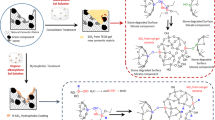Abstract
Alkoxysilanes, low-viscosity monomers capable of polymerizing into the porous network of stone by a sol-gel process, are widely used as consolidants in the restoration of stone monuments. However, since consolidation is a non-reversible application capable of causing serious harmful side effects to the original material, stone consolidation is almost always considered a very risky intervention. Alkoxysilanes are insoluble in water, so co-solvented systems are very often used, but even knowing that the solvent is a determinant parameter for sol-gel reactions, there is still a lack of information regarding how it can influence the stone-alkoxysilane affinity. For two different tetraethoxysilane-acidic co-solvented systems we are reporting both the morphological characteristics showed by gels formedin situ and the affinity reached with the stone in the sandstone consolidation process. Aqueous solutions of ethanol and methyl-ethyl-ketone (MEK) were the solvents compared. SEM and 29Si Solid State NMR were used todetermine the alkoxysilane performance on these silicic-based materials. It was found that using MEK solutions resulted in appreciable sandstone-alkoxysilane interaction, forming a more homogeneous film. On the other hand, ethanol does not promote alkoxysilane-sandstone compatibility. A brittle film is obtained when ethanol is used.
Similar content being viewed by others
Explore related subjects
Discover the latest articles, news and stories from top researchers in related subjects.References
Laurie, A.P. 1924 U.S. Patent, No. 1561988.
Torraca, G. 1976 Treatment of stone in monuments: A review of principles and processes. Proc. Int. Symp. The Conservation of Stone I, eds. Rossi & Manaresi, pp. 297-316. Bologna, Italy.
Wheeler, G., Méndez-Vivar, J., Goins, E., Fleming, S. & Brinker, J., 2000 Proc. 9th International Congress on Deterioration and Conservation of Stone, p. 541. Venice, Italy.
Arkles, B. 1995 Future developments in silicon chemistry. In Progress in Organosilicon Chemistry, eds. B. Marciniec & J. Chojnowsky, pp. 571-581. Switzerland: Gordon & Breach. ISBN 2884491228.
Pierce C.A. 1996 Stone Conservation: An Overview of Current Research. Los Angeles: Getty Center for Education in the Arts, pp. 16-19. ISBN 0892363894
Wheeler, G. 2002 13th International Symposium on Organo-silicon Chemistry. Abstract 3, Guanajuato, Mexico.
Sasse, H.R. & Snethlage, R. 1996 Sci. Technol. Cult. Heritage 5 (1), 85-92.
Sasse, H.R. 2001 Int. J. Restoration Buildings 7 (2), 197-216.
Kass, R.L. 1971 Polym. Eng. Sci. 11, 11-18.
Elfving P. & Jäglid U. 1992 Silane bonding to various mineral surfaces. Report OOK 92:01, ISSN 0283-8575. Department of Inorganic Chemistry, Chalmers University of Technology and University of Göteborg, Sweden.
Cervantes, J., Mendoza-Diaz, G., Álvarez-Gasca, D. & Martínez-Richa, A. 1999 Sol. State Nuclear Magn. Reson. 13, 263-269.
Mosquera, M.J., Pozo, J. & Esquvas, L. 2003 J. Sol-Gel Sci. Tech. 26, 1227-1231.
Brinker, J. & Sherer, G. 1990 Sol-Gel Science: The Physics & Chemistry of Sol-Gel Processing. Boston: Academic Press. ISBN 0121349705.
Plueddemann, E. 1991 Silane Coupling Agents. NewYork: Plenum Press. ISBN 0306434733.
White, L.D. & Tripp, C.P. 2000 J. Colloid Interface Sci. 224, 417.
Voon Ng L. & McCormick A. 1996 J. Phys. Chem. 100, 12517.
Aranda, J. 1996 Internal report: The mineralogical study on pink quarry from the Guanajuato area. Geology Institute, Mexico: National University.
Grimshaw, R. & Searle, A. 1971 The Chemistry and Physics of Clays and Other Ceramic Materials. London: Ernest Benn Ltd. ISBN 1878907441.
Cervantes, J., Aguilera, A., Troncoso, F., Uribe, A., Romero, J., Luna, F.J., Rodriguez, E., Hernandez, L. & Mata, J.L. 1993 By-products from waste treatment for a bench scale trichloro/tetrachlorosilane direct process. In Catalyzed Reactions of Silicon, eds. K.M. Lewis & D.G. Rethwisch, pp. 459-470. New York: Elsevier. ISBN 0444817158.
Brunet, F. & Cabane, B. 1993 J. Non-Cryst. Solids 163, 211.
Brus, J. & Kotlík, P. 1996 Chem. Mater. 8, 2741.
Author information
Authors and Affiliations
Rights and permissions
About this article
Cite this article
Zárraga, R., Alvarez-Gasca, D.E. & Cervantes, J. Solvent effect on TEOS film formation in the sandstone consolidation process. Silicon Chemistry 1, 397–402 (2002). https://doi.org/10.1023/B:SILC.0000025602.64965.e7
Issue Date:
DOI: https://doi.org/10.1023/B:SILC.0000025602.64965.e7





